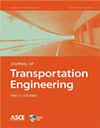求助PDF
{"title":"Impact of COVID-19–Related Travel Restrictions on the Environment and Travel Time Reliability","authors":"Ananya Singh, Sharmili Banik, A. Bachu, L. Vanajakshi, L. Rilett","doi":"10.1061/jtepbs.teeng-7290","DOIUrl":null,"url":null,"abstract":"This study analyzes the effect of the restrictions in traffic movement enforced in order to combat the spread of coronavirus on air quality and travel time reliability under heterogeneous and laneless traffic conditions. A comparative analysis was conducted to examine quantity of pollutants, average travel time distributions (TTD), and their associated travel time reliability (TTR) metrics during the COVID-19 pandemic, postpandemic, and during partial restrictions. Pollutants data (PM2.5, NO2, and NOX) and travel time data for selected locations from Chennai City in India were collected for a sample period of one week using Wi-Fi sensors and state-run air quality monitoring stations. It was observed that the average quantity of PM2.5, NO2, and NOX were increased by 433.1%, 681.4%, and 99.2%, respectively, during the postlockdown period. Correlation analysis also indicated that all considered air pollutants are moderately correlated to Wi-Fi hits, albeit to varied degrees. From the analysis, it was also found that average TTD mean and interquartile range values were increased by 47.2% and 105.2%. In addition, the buffer time index, planning time index, travel index, and capacity buffer index associated with these TTD metrics were increased by 148.1%, 63.7%, 42.8%, and 202.9%, respectively, soon after relaxing travel restrictions. © 2023 American Society of Civil Engineers.","PeriodicalId":56037,"journal":{"name":"Journal of Transportation Engineering Part A-Systems","volume":"49 1","pages":""},"PeriodicalIF":2.1000,"publicationDate":"2023-07-01","publicationTypes":"Journal Article","fieldsOfStudy":null,"isOpenAccess":false,"openAccessPdf":"","citationCount":"0","resultStr":null,"platform":"Semanticscholar","paperid":null,"PeriodicalName":"Journal of Transportation Engineering Part A-Systems","FirstCategoryId":"5","ListUrlMain":"https://doi.org/10.1061/jtepbs.teeng-7290","RegionNum":4,"RegionCategory":"工程技术","ArticlePicture":[],"TitleCN":null,"AbstractTextCN":null,"PMCID":null,"EPubDate":"","PubModel":"","JCR":"Q3","JCRName":"ENGINEERING, CIVIL","Score":null,"Total":0}
引用次数: 0
引用
批量引用


